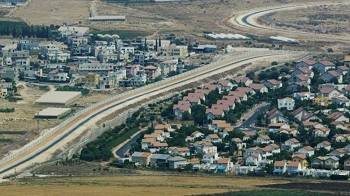Gulf News has reported there is a clear inequality in the distribution of water between Palestinians and Israeli settlers living in the West Bank.
Palestinians are allotted 70 liters per person per day, which is below the World Health Organisation’s recommendation of 100 liters per person per day.
Meanwhile, Israeli settlers receive around 300 liters per person per day.
The difference can be seen clearly with the existence of lush gardens, parks and swimming pools in the Israeli settlements, which are illegal under international law.
An aerial view over the West Bank showing a Palestinian village on the left and a Jewish settlement on the right.
Palestinians live in Al Jab’a, a mountain village situated in the Israeli-occupied West Bank, and unlike the Israeli settlements surrounding it, the village is facing extensive water shortages.
A reservoir, pipeline and a pipe was built in 2013 by an Italian non-governmental organisation allowing the residents of the village to have limited access to Israeli water supplies.
"Before, we had to walk many times a day to the nearby springs to fill our bottles and buckets," said Omar Musa, 18, who lives near one of the reservoirs.
"I was happy when I knew I would have water at home."
But according to families in Al Jab’a the water is not enough, and they are increasingly worried that the system they use for water could be demolished because it is not officially approved.
Residents like Musa and his family fear that the reservoirs as well as their homes could be destroyed by Israeli authorities.
Construction by Palestinians is forbidden in an area covering 60 percent of the West Bank, which includes Al Jab’a.
Water restrictions
Mekorot, Israel’s national water company, is responsible for supplying water to Palestinians. However, according to Al Jazeera, it implements a policy of water cuts during the summer, cutting supply by more than 50 percent.
Many of the rural and Bedouin communities in West Bank are not connected to Mekorot’s network.
Initially, Al Jab’a was one of them, and only 10 percent of homes there were part of Mekorot’s distribution system until pipes and reservoirs built in 2013 extended water access to the remaining households.
But this didn’t completely solve the water problems of the community, because Mekerot supplied water intermittently, forcing the families to hurry and store as much water as possible before it ran out.
Other Palestinian neighborhoods in the West Bank have been undergoing the same problem.
"Since the water crisis started in June, the municipality has been able to supply water for only one hour twice a week," Enas Taha, a resident of the village of Kafr al-Deek, told Al Jazeera.
"It is a very stressful situation. I have to consider and prioritise every single drop of water I use. We barely have enough to drink, cook, shower and use the bathroom," she said.
A report from the UN Environment Programme said that Israel was using the majority of the water resources available in the West Bank for itself.
However, Israel has said that it shares the water and provides Palestinians with double the amount of water annually that was agreed to in the 1995 Oslo accords.
PHOTO CAPTION
An aerial view over the West Bank showing a Palestinian village on the left and a Jewish settlement on the right.
TRTWorld


 Home
Home Discover Islam
Discover Islam Quran Recitations
Quran Recitations Lectures
Lectures
 Fatwa
Fatwa Articles
Articles Fiqh
Fiqh E-Books
E-Books Boys & Girls
Boys & Girls  Articles
Articles










